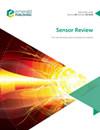A flexible pressure sensor with interference immunity capability
IF 1.4
4区 工程技术
Q3 INSTRUMENTS & INSTRUMENTATION
引用次数: 1
Abstract
Purpose Flexible pressure sensor arrays have promising applications in analog haptics, reconfiguration of sensory functions, artificial intelligence, wearable devices and human-computer interaction. The force disturbance generated by the connecting material between the sensor array units will reduce the detection accuracy of the unit. The purpose of this paper is to propose a flexible pressure sensor with interference immunity capability. A C-type bridge flexible piezoelectric structure is used to improve the pressure perturbation. The interference immunity capability of the sensor has been improved. Design/methodology/approach In this paper, a C-type pressure sensor array structure by rapid injection moulding is manufactured through the positive piezoelectric effect of a piezoelectric material. The feasibility of C-type interference immunity structure in a flexible sensor array is verified by further analysis and experiment. A flexible pressure sensor array with C-type interference immunity structure has been proposed. Findings In this paper, we present the results of the perturbation experiment results of the C-type pressure sensor array, showing that the perturbation error is less than 8%. The test of the flexible sensor array show that the sensor can identify the curved angle of up to 120 °, and the output sensitivity of the sensor in the horizontal state reaches 0.12 V/N, and the sensor can withstand the pressure of 80 N. The flexible sensor can work stably in the stretch rate range of 0–8.6% and the stretch length range of 0–6 mm. Originality/value In this paper, C-type pressure sensor array structure is fabricated by rapid injection moulding for the first time. The research in this paper can effectively reduce the disturbance of input pressure on the sensor’s internal array and improve the output accuracy. The sensor can intuitively reflect the number of fingers sliding on the sensor by the order in which the maximum voltage appears. Due to the strong interference immunity capability and flexibility of the flexible sensor array mechanism, it has a broad application prospect in the practical fields of haptic simulation, perceptual function reconstruction, artificial intelligence, wearable devices and human–computer interaction.一种具有抗干扰能力的柔性压力传感器
目的柔性压力传感器阵列在模拟触觉、传感功能重构、人工智能、可穿戴设备和人机交互等领域具有广阔的应用前景。传感器阵列单元之间的连接材料产生的力扰动会降低单元的检测精度。本文的目的是提出一种具有抗干扰能力的柔性压力传感器。采用C型桥柔性压电结构来改善压力扰动。传感器的抗干扰能力得到了提高。设计/方法/方法本文通过压电材料的正压电效应,通过快速注射成型制造了C型压力传感器阵列结构。通过进一步的分析和实验验证了C型抗干扰结构在柔性传感器阵列中的可行性。提出了一种具有C型抗干扰结构的柔性压力传感器阵列。本文给出了C型压力传感器阵列的微扰实验结果,表明微扰误差小于8%。柔性传感器阵列的测试表明,该传感器可以识别高达120°的弯曲角度,传感器在水平状态下的输出灵敏度达到0.12 V/N,传感器可以承受80的压力 N.柔性传感器可以在0–8.6%的拉伸率范围和0–6的拉伸长度范围内稳定工作 mm.原始性/值本文首次采用快速注射成型的方法制备了C型压力传感器阵列结构。本文的研究可以有效地减少输入压力对传感器内部阵列的干扰,提高输出精度。传感器可以按照最大电压出现的顺序直观地反映手指在传感器上滑动的数量。由于柔性传感器阵列机构具有较强的抗干扰能力和灵活性,在触觉仿真、感知功能重建、人工智能、可穿戴设备和人机交互等实际领域具有广阔的应用前景。
本文章由计算机程序翻译,如有差异,请以英文原文为准。
求助全文
约1分钟内获得全文
求助全文
来源期刊

Sensor Review
工程技术-仪器仪表
CiteScore
3.40
自引率
6.20%
发文量
50
审稿时长
3.7 months
期刊介绍:
Sensor Review publishes peer reviewed state-of-the-art articles and specially commissioned technology reviews. Each issue of this multidisciplinary journal includes high quality original content covering all aspects of sensors and their applications, and reflecting the most interesting and strategically important research and development activities from around the world. Because of this, readers can stay at the very forefront of high technology sensor developments.
Emphasis is placed on detailed independent regular and review articles identifying the full range of sensors currently available for specific applications, as well as highlighting those areas of technology showing great potential for the future. The journal encourages authors to consider the practical and social implications of their articles.
All articles undergo a rigorous double-blind peer review process which involves an initial assessment of suitability of an article for the journal followed by sending it to, at least two reviewers in the field if deemed suitable.
Sensor Review’s coverage includes, but is not restricted to:
Mechanical sensors – position, displacement, proximity, velocity, acceleration, vibration, force, torque, pressure, and flow sensors
Electric and magnetic sensors – resistance, inductive, capacitive, piezoelectric, eddy-current, electromagnetic, photoelectric, and thermoelectric sensors
Temperature sensors, infrared sensors, humidity sensors
Optical, electro-optical and fibre-optic sensors and systems, photonic sensors
Biosensors, wearable and implantable sensors and systems, immunosensors
Gas and chemical sensors and systems, polymer sensors
Acoustic and ultrasonic sensors
Haptic sensors and devices
Smart and intelligent sensors and systems
Nanosensors, NEMS, MEMS, and BioMEMS
Quantum sensors
Sensor systems: sensor data fusion, signals, processing and interfacing, signal conditioning.
 求助内容:
求助内容: 应助结果提醒方式:
应助结果提醒方式:


